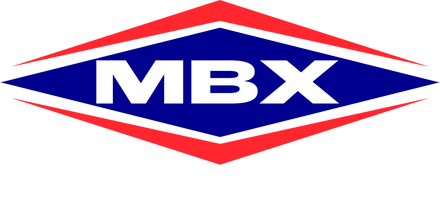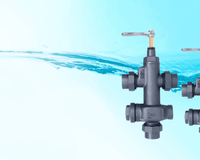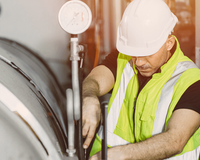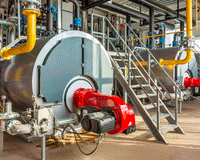Industrial boilers are essential equipment for various processes
The industrial boiler is a piece of equipment that has the function of producing high volumes of steam.
For a better understanding, it is worth checking out a more technical definition of what boilers are. This definition is present in Regulatory Standard number 13 (NR-13), which states:
“ Steam boilers are equipment designed to produce and accumulate steam under pressure higher than atmospheric pressure, using any energy source, designed in accordance with relevant codes, with the exception of reboilers and similar equipment ”.
Due to this characteristic, the industrial boiler is essential equipment in various types of industries, such as: lumber, cold storage, dairy factories and the textile industry.
In these industries, the steam generated by the boiler will be used in many processes, such as providing heat for the pasteurization procedure in the dairy factory, providing steam for the fat-processing sector in a cold storage facility or even generating energy in the thermoelectric industry.
Operation of an industrial boiler
In simple terms, every industrial boiler is a huge closed tank that has the job of heating water, forming a vaporized fluid that will later be used in various heating processes or applications.
To achieve this, the first step in generating steam in an industrial boiler is the release and subsequent combustion of a wide range of fuels. This process occurs in a separate container, which is attached to the boiler, called a burner or furnace.
In the furnace, fuel is released and burned, which in turn heats the water, transforming it into steam, which then flows through the pipes to the equipment that requires this input.
It is important to highlight that the path of the generated steam varies depending on the type of industrial boiler, and can occur in two ways:
- Fire tube (fire tube boilers); and
- Water tube (water tube boilers).
Operation of industrial boiler types
To truly understand how an industrial boiler works, you need to be aware that there are some boiler construction models that the industry can choose from and each of them has its own specific operating pattern.
Find out below the main ones and how they work:
Fire tube boiler
The fire tube industrial boiler has fire tubes surrounded by water. After combustion, in this boiler the resulting gases pass through the tubes, which give off heat to the liquid during the passage.
From a construction point of view, this boiler is simpler and, even though it has a comparatively lower thermal output, it perfectly meets the needs of the vast majority of industrial processes.
Watertube boiler
In the industrial boiler with a water tube feature, the water to be transformed into steam passes through the pipes with the gas combustion process occurring around the tubes.
As a characteristic, water tube boilers withstand high pressures and temperatures, having the capacity to produce large quantities of steam. Therefore, this type of boiler is mainly used in power generation, especially in thermoelectric plants.
Mixed boiler
Finally, mixed boilers represent the combination of water-tube and fire-tube boilers.
In these, the combustion process is similar to that of fire tube boilers, but they also have water tube walls, a characteristic of water tube boilers. This type of industrial boiler usually withstands low pressures and temperatures.
Finally, if you need to increase the performance of your industrial boiler, we invite you to discover the portfolio of accessory products from MBX Máquinas.
We focus on increasing our customers' productivity by developing equipment that is effective, extremely useful and easy to use.
Enjoy and Download MBX Máquinas product manuals and have technical assistance always close to you.




